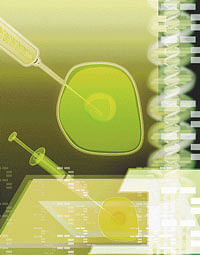Mechanics of life

The last 10 years launched a new age of science, and it came as no surprise. Researchers had foreseen the rise of biology in the 1990s and expected nothing less than a transformation of modern medicine and giant leaps in our knowledge of life on earth.
They cannot be disappointed. In the last 10 years, scientists have looked deeper into the mechanics of life than ever before. They have learned how molecules come together to make living organisms, how biological glitches cause common diseases, and have come within a whisker of creating new lifeforms in the laboratory.
Genetics was at the heart of the revolution. Scientific and technological advances allowed researchers to read every letter of an organism’s genome. The letters make genes, which are the templates for proteins that make cells. And the cells, in the tens of trillions, build the animals and plants around us.
The first major achievement came in 2001 when the 13-year, $4bn (£2.5bn) human genome project produced the first draft of the human genetic code. The huge task became a race between a global consortium of publicly funded scientists and an American genetics pioneer, Craig Venter. It was, said Venter, “the most important scientific effort humankind has ever mounted”. The human genome project put the essence of humanity into numbers.
Our genetic code is three billion letters long, grouped into around 25,000 genes. Francis Collins, head of the public genome project, declared it the first draft of our own book of life. “We’ve read it from cover to cover and we’ve discovered some pretty amazing surprises,” he said.
Scientific revolutions have a long history of taking humans down a peg or two. Copernicus declared the Earth to be just another planet orbiting the sun.
Darwin painted us as glorified apes, and Watson and Crick said life is but a bag of self-replicating molecules called DNA. The genetics revolution was no different. As more organisms submitted to genetic analysis, scientists learned that humans were not so different from other organisms. We share more than 95 per cent of our genes with chimps and around 30 per cent with bananas. Nematode worms, which grow to 1mm long, have a similar number of genes to humans.
Today, scientists have read the genomes of more than 180 organisms. They include the malaria parasite, Plasmodium falciparum, and a host of other pathogens, as well as rice, maize and other food crops. The information gives scientists insights to combat disease and make dietary staples more resilient.
Cheaper sequencing technology
Genetics came into its own when sequencing technology became cheap and fast. It allowed scientists to compare the genomes of tens of thousands of sick and healthy people and find flaws in DNA that lead to a vast range of ailments. The list so far includes defects linked to diabetes, high blood pressure, rheumatoid arthritis and heart disease. The role of genetics in disease has turned out to be more subtle than many scientists had hoped. Only rarely does one gene cause one ailment. Scientists now know the picture is more complicated still.
Almost every cell in the body contains the genetic code in full but every tissue uses it differently.
Some genes are turned up while others are silenced to keep heart cells beating and brain cells firing. Sometimes, this exquisite control breaks down, causing cancers and other common diseases. A global effort to understand this “epigenome” is under way.
As genetic sequencing became more advanced, it was put to use in ways that had only existed in science fiction. In 2008, scientists pieced together the genome of a woolly mammoth dug out of the Siberian permafrost. A year later, researchers extracted fragments of ancient DNA from the fossilised bones of Neanderthals and created the first genetic profile of a human relative. Comparisons revealed genes involved in speech and language that shed light on what it means to be human.
The new age of biology brought scientists into conflict with opponents who considered some of their experiments offensive – above all, the use of embryonic stem cells, collected from embryos left over from IVF treatment, to regenerate damaged or diseased organs. The research was hampered by restrictions laid down by the Bush administration in the US and independently in other countries.
New stem cell technology sidesteps the moral controversy by using genetic tricks to turn adult skin tissue into cells that behave just like embryonic stem cells.
Scientists have tailor-made these induced pluripotent stem (iPS) cells from patients’ own skin. These have enormous advantages. They can be used to study a patient’s disease in unprecedented detail, and can potentially grow into replacement tissues that will not be rejected by the immune system.
Controlling living tissue
The invention of iPS cells demonstrated how skilled scientists had become at controlling living tissue.
In the next decade, scientists will begin clinical trials to treat patients with iPS cells, a revolution expected to have a profound impact on public health.
In this year, scientists could reveal the first artificial living organism. Venter, who began the decade with an acrimonious battle over the human genome, hopes to create the first “trillion-dollar organisms” to produce hydrogen for the green economy. If he succeeds, predictions of a new age of biology will look all the more prescient.
The Guardian
Deccan Herald is on WhatsApp Channels| Join now for Breaking News & Editor's Picks